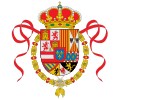Édouard Empain
Édouard Louis Joseph, Baron Empain (20 September 1852 – 22 July 1929), was a wealthy Walloon Belgian engineer, entrepreneur, financier and industrialist, as well as an amateur Egyptologist. During World War I he became a known Major-General.
Édouard, Baron Empain | |
|---|---|
| Born | Édouard Louis Joseph Empain 20 September 1852 Belœil, Belgium |
| Died | 22 July 1929 (aged 76) Woluwe, Belgium |
| Nationality | Belgian |
| Occupation | Industrialist, General and amateur Egyptologist |
| Known for | Building Paris Métro and town of Heliopolis |
Early life
Empain was born at Belœil, Belgium, and was the son of schoolteacher[1] François Julien Empain and his wife Catherine (née Lolivier). He went into business with his brother, Baron François Empain and other family members, and amassed a great fortune.
Empain began his career a draughtsman at a metallurgical company, Société métallurgique, in 1878,[2] and became involved in railway construction when he noticed that transport infrastructure in the countryside was inadequate. After success in Belgium with the Liège-Jemeppe line,[2] his companies developed several railway lines in France, including the creation of the Paris Métro.
Because he felt that he depended too much on the banks for his industrial plans, in 1881 he founded his own bank, Banque Empain, which later became the Belgian Industrial Bank ("Banque Industrielle Belge").[2] The Empain group of companies expanded greatly throughout the 1890s, constructing electric urban tramlines in Europe, Russia, China, the Belgian Congo, and in Cairo, Egypt. Desiring to also be independent of electricity producers, Empain also was involved in forming a number of electricity companies to power his projects.[2]
Egypt
Édouard Empain arrived in Egypt in January 1904, intending to rescue one of the projects of his company S.A. des Chemins de Fer de la Basse-Egypte; being the construction of a railway line linking Mansourah (on the Nile river) to Matariya (on the far side of Lake Manzala from Port Said).[3]
In 1906, Empain established the Cairo Electric Railways and Heliopolis Oases Company, which bought a very large stretch of desert (25 square kilometres) to the northeast of Cairo at a low price from the Egyptian government.[3] Commencing in 1906 this company proceeded with the building of the new town of Heliopolis, in the desert ten kilometers from the center of Cairo. It was designed as a "city of luxury and leisure", with broad avenues and equipped with all necessary conveniences and infrastructure; water, drains, electricity, hotel facilities, such as the Heliopolis Palace Hotel[3] (formerly the presidential palace of ex-President Hosni Mubarak) and Heliopolis House, and recreational amenities including a golf course, racetrack and park. In addition, there was housing for rent, offered in a range of innovative design types targeting specific social classes with detached and terraced villas, apartment buildings, tenement blocks with balcony access and workers' bungalows.
Today, Baron Empain is perhaps best known by modern visitors to Egypt for the building of a palace (the Palais Hindou) in the Avenue des Palais (renamed Orouba Avenue following the Egyptian Revolution of 1952) Heliopolis, Egypt. Inspired by Angkor Wat in Cambodia and the Hindu temples of Orissa,, the Baron Empain palace was designed by French architect Alexandre Marcel (1860–1928) and decorated by Georges-Louis Claude (1879–1963), with construction being completed in 1911.[1]
In 1905, Empain assisted the Belgian government in the purchase of an Old Kingdom mastaba for the royal museum in Brussels, of which he was a benefactor. In 1907 he received the title of Baron, and also suggested to Belgian Egyptologist Jean Capart that he excavate at Heliopolis, where his building constructions were underway. He also made it possible for Capart to acquire some fine ancient artefacts for the Brussels Museum.
Military Career
During World War I, he was given the rank of general and directed armaments production at Paris and Le Havre for the Belgian army.
He died in Woluwe, Belgium, and was buried in the Our Lady of Heliopolis Basilica (Basilique Notre-Dame d'Héliopolis). In Egypt.[4]
He was succeeded as baron by his son, Jean Empain, who married American burlesque performer Rozell Rowland (sometimes Rozelle Rowland). They entertained frequently at the Heliopolis. Jean, 2nd Baron Empain, was succeeded by their son, Édouard-Jean Empain.
Honours
.svg.png)
- Honorary Aide-de-camp of the HM the King.[5]
- War Cross
- Grand Officer in the Order of Leopold.
.svg.png)



See also
- The town of Kindu in the Belgian Congo was known as Port Empain.
- Heliopolis Oasis Company
- Heliopolis
Notes
- THE BELGIANS OF EGYPT, 13 May 1995 Archived 19 July 2006 at the Wayback Machine at www.egy.com
- EMPAIN Edouard at www.wallonie-en-ligne.net
- BELGIAN COMPANIES IN EGYPT* Archived 14 March 2007 at the Wayback Machine at www.booneshares.com
- Cook, William (12 September 2012). "Surrounded by barbed wire and shrouded in superstition: The crumbling Egyptian palace of tragic Belgian millionaire who raised a city from the desert". Daily Mail. Retrieved 3 January 2013.
- http://www.ars-moriendi.be/EMPAIN.HTM
Further reading
- Howard Shakespeare, Belgian Companies in Egypt, (published by the International Bond & Share Society, 1998).
- Van Loo, Anne & Bruwier, Marie-Cécile (eds.), Héliopolis, Brussels: Fonds Mercator, 2010, 229 p., richly illustrated ISBN 978-90-6153-930-8.
- Une Donation d'antiquités égyptiennes aux Musées royaux de Bruxelles, (1911).
External links
- An article from the Egyptian Mail, by Samir Raafat, on the founding of the Cairo Electric Railways & Heliopolis Oases Company.
- An article from the Egyptian Mail, by Samir Raafat. on the building of the Palace of the Baron Empain.
- A selection of images of the palace of Baron Empain (in Heliopolis, Egypt)